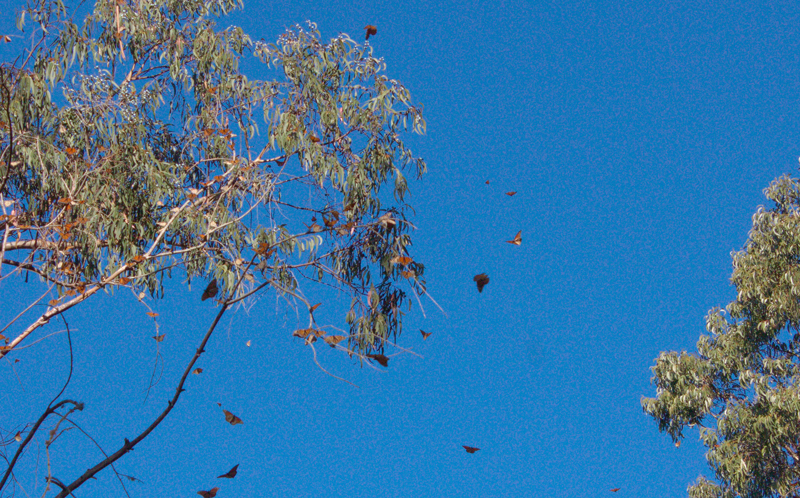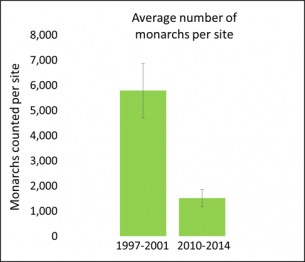A new report, State of the Monarch Butterfly Overwintering Sites in California, released by the Xerces Society shows that in less than two decades the number of monarchs which overwinter along the California coast declined by an alarming 74% . This significant loss of butterflies mirrors the troubling trend seen in monarchs in central Mexico in recent years. In addition, the report presents a list of the 50 monarch overwintering sites in California that are most in need of conservation attention, so that land managers and policy makers can make the best use of limited conservation resources. The report was completed with funding from the US Fish and Wildlife Service and Xerces Society members.

Volunteers from the Xerces Society’s annual Western Monarch Thanksgiving Count (WMTC), track the California overwintering population size and habitat conditions each fall during a three-week period centered on Thanksgiving. The WMTC, begun in 1997 and now led by the Xerces Society and Mia Monroe, is the longest-running effort to monitor overwintering monarchs in California. Monarchs have been observed overwintering at over 400 locations in California since the 1970s and 300 of these sites have been surveyed in the WMTC (with a third to two-thirds of sites surveyed in any one year).
The report includes an analysis of western monarch population trends. A comparison of the average number of butterflies at sites regularly monitored during the periods 1997–2001 and 2010–2014 shows that the number of overwintering monarchs fell by 74%.

Monarch butterflies are distributed throughout North America. While eastern monarchs migrate to central Mexico for the winter, western monarchs spend winter on the California coast or in Mexico. Although the number of monarchs overwintering in Mexico experienced an uptick last year, overall decline since the late 1990s is comparable to the decline in California over the same time period. Monarchs overwintering in Mexico have undergone an 84% decline from their population maximum in 1996.
The loss of breeding habitat, especially milkweed, due to the increased use of genetically modified herbicide-resistant crops, is an important factor influencing the decline of monarchs in the eastern US. Evidence for breeding habitat loss is less clear in the western states and the continent-wide decline in monarch numbers may be compounded by other stressors such as disease, increased frequency of drought due to climate change, and the widespread use of neonicotinoid insecticides, as well as destruction of their overwintering habitat.
Dozens of overwintering sites in California have been lost in previous decades to housing development; many sites continue to be threatened by encroaching development. Grove senescence, pests, and disease, as well as a lack of active management, have degraded the delicate microhabitat monarchs require for overwintering at many additional sites. Together, these stressors put monarchs overwintering on the coast at risk.
Monarchs and their overwintering groves fall under a patchwork of legal protection in California but are not comprehensively protected or actively managed for monarchs. However, the monarch has recently been added as a Species of Greatest Conservation Need by multiple western states including California, which will expand the ability of state agencies to engage in monarch conservation. The California State Legislature recently passed bill AB 559, which authorizes the California Department of Fish and Wildlife to take actions to conserve monarch butterflies and their habitats. In addition, the monarch butterfly is under review by the U.S. Fish and Wildlife Service for protection as a threatened species under the federal Endangered Species Act, with a final listing decision expected in June 2019.
Based on the severity of decline and importance to the remaining population, the report prioritizes the top 50 California overwintering sites for protection and management. The sites in greatest need of attention span the monarch’s nearly 1,000 km (620 miles) overwintering range along the Pacific coast and the East Bay of San Francisco. Included are sites such as Pismo Beach and Morro Bay Golf Course in San Luis Obispo County, Ellwood Main in Santa Barbara County, Pacific Grove Sanctuary in Monterey County, Lighthouse Field State Beach and Moran Lake in Santa Cruz County, and San Leandro Golf Course and Ardenwood Historic Farm in Alameda County. While the majority of the top 50 priority sites are publicly owned, a substantial number of the largest sites are in private hands.
In addition to documenting decline and prioritizing overwintering sites, the report also identifies important knowledge gaps about monarchs in the West and identifies conservation issues and general management recommendations for overwintering groves. Intended for use by land managers, policy makers, restoration practitioners, and researchers, this report aims to raise awareness about the importance of California overwintering sites in conserving monarch butterflies and their migratory phenomenon in the West.
The Xerces Society has been a leader in monarch conservation since the 1980s and has gone one to build one of the largest science-based monarch conservation teams in the United States (currently 9 FTE) working today. The Xerces team has amassed rigorous, science-based monarch conservation experience, including expertise in habitat restoration, habitat management, species monitoring, and conservation education.



